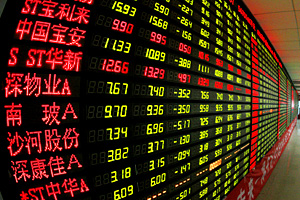
China’s economy is slowing.
The latest figures confirm it. During the quarter just gone, China grew at its slowest pace since 2009.
And it looks like annual growth will be the weakest since 1990.
It’s hardly as if this is unexpected. People have been predicting a slowdown for China at regular intervals over the past decade.
But although it doesn’t sound like it, this slowdown could be good news for China – and investors in the country…
China slowdown – bad news for commodities and Australia
China’s gross domestic product (GDP) grew by 7.3% in the third quarter of 2014. That was the slowest performance since the aftermath of the financial crisis in 2008, and roughly in line with what analysts had expected.
The main thing holding back growth is the bursting property bubble. In the first nine months of the year, sales fell by 10.8% compared with the same period in 2013. Property prices are falling, and while investment in real estate is still growing, it’s at a much slower pace.
China’s slowdown is one of the main reasons behind the slide in commodity prices. As my colleague Merryn wrote recently, this might have some way to go yet, partly because many of those commodity stockpiles were being used as collateral for loans, rather than to actually build anything.
It’s also bad news for resource-dependent Australia. The Australian dollar has dropped a long way off its perch since the days it was running neck and neck with the US dollar. But I wouldn’t be surprised to see it fall further from here in the longer term.
That said, broadly speaking the economy is doing better than most people had expected. China is keen to change the focus of its economy. It has been too dependent on building as much stuff as possible, and keeping unprofitable factories afloat.
Now the desire is to move more towards an economy that’s driven by demand from domestic consumers, rather than overseas buyers or huge road-building projects. And the progress on this front is promising.
As Julian Evans-Pritchard of Capital Economics points out, wages are rising faster than GDP growth, which means “that the average household is enjoying an increasing share of the dividends from growth”. That means “consumption is holding up relatively well”.
In other words, even though “growth has slowed, it reflects a welcome rebalancing away from excess investment in certain sectors… and is not cause for significant concern”.
No money-printing and slowing growth – but China’s still a buy for investors
Clearly, there’s also the hope that if growth slows too much, China will feel the need to do the equivalent of quantitative easing (QE). It’ll pump a load more credit around the system to get things moving again.
I’m not as convinced that this will happen. China needs to change, and the trouble with things like QE is that they hinder change. QE in the US and UK has turned into a way to keep a broken model running beyond its sell-by date. That’s the last thing that China wants if it’s at all serious about moving towards being a more consumer-oriented economy.
I imagine that instead, China’s leaders would rather do just enough to prevent a major social or economic meltdown. That may still mean a lot of stimulus getting done, but I wouldn’t be betting on a 2008-style stimulus package.
As Capital Economics puts it: “with policymakers now prioritising employment and economic rebalancing over growth, we don’t think they will feel the need to act aggressively to shore up the economy in response to today’s data”.
A slowing economy? With no money printing on the horizon? It doesn’t sound like a promising scenario for investors.
However, there are reasons to get excited about Chinese stocks. For a start, they’re cheap. And one good way to make money in markets is by buying stuff when it’s cheap, and selling when it gets expensive.
There’s a more specific reason why investors are getting excited about China just now – it’s what’s known as the ‘Shanghai-Hong Kong Stock Connect’. Essentially, this is going to be a way for foreign investors to get more access than ever before to mainland Chinese stocks, via Hong Kong.
Frustratingly for the brokers and regulators concerned, the government keeps pushing back the deadline for the connect to start – it had originally been expected by the end of this month. But it still seems likely to start soon.
The end result is that a lot more money will be going into Chinese stocks, and a lot of people want to be positioned for when that happens. It makes now look like a sensible time to get some exposure to China for yourself.
We looked at some of the best ways to get exposure in a recent edition of MoneyWeek magazine. If you’re not already a subscriber you can get your first four issues free here.
• This article is taken from our free daily investment email, Money Morning. Sign up to Money Morning here.
Our recommended articles for today
How falling oil prices will affect Latin America
Many Latin American countries depend on oil exports for income, says James McKeigue. Falling crude prices could spell trouble ahead.
Stocks are still your best bet in volatile markets
Despite all the market turmoil, it’s best to stick with stocks, says Bengt Saelensminde. After all, there’s nowhere else to go.
On this day in history
21 October 1520: Magellan finds the path to the Pacific
On this day in 1520, a fleet of five ships, led by Ferdinand Magellan in search of a passage to the Pacific, first entered the waterway that now bears his name.